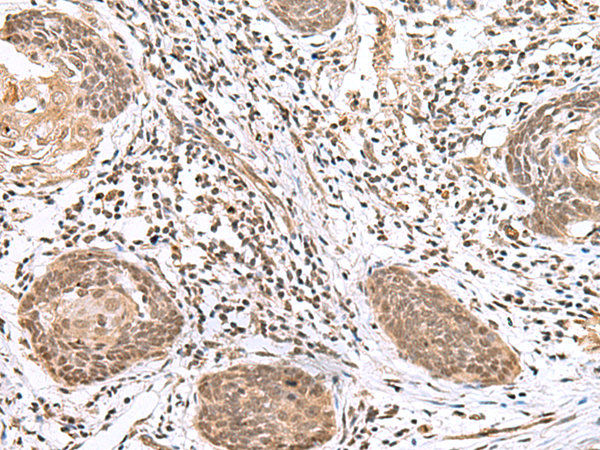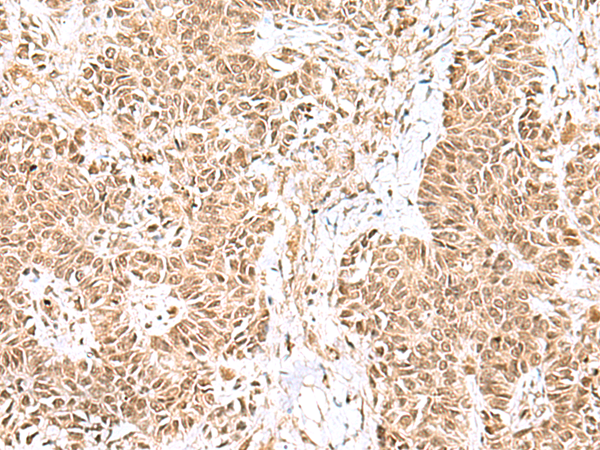

| WB | 咨询技术 | Human,Mouse,Rat |
| IF | 咨询技术 | Human,Mouse,Rat |
| IHC | 1/25-1/100 | Human,Mouse,Rat |
| ICC | 技术咨询 | Human,Mouse,Rat |
| FCM | 咨询技术 | Human,Mouse,Rat |
| Elisa | 1/5000-1/10000 | Human,Mouse,Rat |
| Aliases | CJS; HPE9; PHS2; THP1; THP2 |
| Host/Isotype | Rabbit IgG |
| Antibody Type | Primary antibody |
| Storage | Store at 4°C short term. Aliquot and store at -20°C long term. Avoid freeze/thaw cycles. |
| Species Reactivity | Human, Mouse |
| Immunogen | Synthetic peptide of human GLI2 |
| Formulation | Purified antibody in PBS with 0.05% sodium azide and 50% glycerol. |
+ +
以下是3篇关于GLI2抗体的研究文献摘要(模拟虚构内容供参考):
---
1. **文献名称**: *GLI2 antibody validation in Hedgehog pathway activation models*
**作者**: Smith J, et al.
**摘要**: 本研究系统验证了多种市售GLI2抗体的特异性,通过CRISPR敲除细胞系和Western blot分析,筛选出适用于免疫组化和染色质免疫沉淀(ChIP)的高效抗体,并证明其在基底细胞癌组织中可准确检测GLI2蛋白异常激活。
---
2. **文献名称**: *Role of GLI2 in pancreatic cancer progression revealed by antibody-based profiling*
**作者**: Lee H, et al.
**摘要**: 利用特异性GLI2抗体对胰腺癌组织进行免疫荧光分析,发现GLI2核定位与患者预后不良显著相关,并通过体外实验证实GLI2调控EMT(上皮间质转化)关键基因,提示其作为治疗靶点的潜力。
---
3. **文献名称**: *GLI2 antibody cross-reactivity with GLI3 in mammalian developmental studies*
**作者**: Garcia R, et al.
**摘要**: 评估GLI2抗体在小鼠胚胎发育研究中的特异性,发现部分抗体存在与GLI3蛋白交叉反应现象,强调在Hedgehog通路研究中需结合基因敲除模型验证抗体可靠性,避免实验结论偏差。
---
注:以上为模拟内容,实际文献需通过PubMed/Google Scholar检索关键词如"GLI2 antibody validation"或"GLI2 immunohistochemistry"获取。
The GLI2 antibody is a crucial tool in studying the Hedgehog (Hh) signaling pathway, a key regulator of embryonic development, tissue homeostasis, and cancer. GLI2. a zinc-finger transcription factor, acts as a primary mediator of Hh signaling. Upon pathway activation, it translocates to the nucleus to regulate target genes involved in cell proliferation, differentiation, and survival. Unlike GLI1. which is strictly an activator, GLI2 can function as both an activator and a repressor, depending on post-translational modifications and cellular context.
Antibodies targeting GLI2 are widely used in research to detect its expression, localization, and activation status in various biological systems. They are essential for techniques like Western blotting, immunohistochemistry, and immunofluorescence, helping to elucidate GLI2's role in developmental disorders (e.g., holoprosencephaly) and cancers (e.g., basal cell carcinoma, medulloblastoma, and glioblastoma). Dysregulation of GLI2 is linked to tumor progression, stemness, and drug resistance, making it a potential therapeutic target.
Commercial GLI2 antibodies are often raised against specific epitopes, such as the N-terminal or C-terminal regions, with validation in knockout cell lines to ensure specificity. Researchers must select antibodies validated for their specific applications, as cross-reactivity with other GLI family members (GLI1/GLI3) can occur. Understanding GLI2 dynamics through these antibodies continues to advance insights into Hh pathway mechanisms and therapeutic strategies.
×